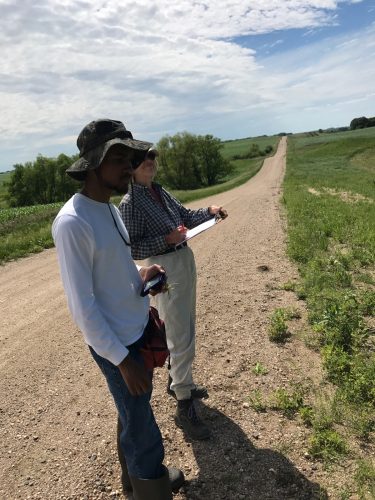Evan-
The first thing that comes to me when I think about East Riley is definitely the poison ivy. The notorious three leafed plant made me hesitant to get any closer to investigate the site. Fortunately, there were a few Echinacea plants present closer to the side of the road. Both sides of the field were bordered by agricultural fields. The agricultural field facing north was growing soybean while the field facing south was growing corn. When out at the site I didn’t notice any solitary bees flying around, but next time I’m at East Riley I would want to observe how frequently they fly to this specific site even with the large amount of poison ivy present.
Riley-
Nothing is more exciting than arriving to a site that shares one’s name. That being said, I had high expectations for a locale sharing my alias; I anticipated a diverse array of species as well as a slew of budding Echinacea heads. Unfortunately, my wish for high species richness did not come true, but I was lucky enough to spot 8 Echinacea heads. Although the exact land use history of the site was unknown to myself, I could only speculate (with the help of Ruth) that the land was previously used for agriculture due to low plant diversity and a lack of remnant prairie indicator species. My experience at East Riley as one of my first impressions of a non-remnant prairie will leave a lasting impact on me because the difference in plant community composition between it and remnant prairie is so immense. It is amazing to me how years of land use can be summarized by a plant layer on topsoil and how much we can learn from this green blanket.
Ruth –
As the member of our team who had been to East Riley quite a few times, I noted its usual great extent of bare ground from which numerous Echinacea with nicely developing flowering stems were emerging. Here, there is a rather wide (over a meter, I’d say) road edge that is level with the road surface. This edge is frequently scraped by snow plows and other road maintenance equipment. The mature Echinacea, with their deep taproots, tolerate this remarkably well, resprouting over many years. Other species typical of unbroken prairie, like leadplant, are not abundant here and may be less tolerant of the scraping. At this site, we have found many seedlings of Echinacea each year for a decade and have relocated them in subsequent years to monitor their survival and (eventual) flowering. Amy Dykstra led this seedling project and has been working on this dataset this year. I don’t remember such vigorous poison ivy in the past. Important to beware of that patch!!

Ruth draws a map of East Riley while Evan enters site data onto his Visor.

Leave a Reply